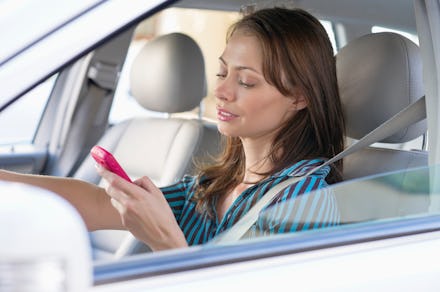The Personality Trait That People Who Text and Drive Have in Common

Do you text while driving? You likely share a fundamental trait with others who do the same.
Researchers at Pennsylvania State University have identified a common behavioral characteristic among people who engage in the risky business of texting and driving: impulsiveness. Their study, published in the October issue of Accident Analysis & Prevention, looked at delayed discounting — or people's devaluation of a delayed reward — among those who said they frequently text while driving, and those who said they do not.
Those who regularly partake in this tempting but dangerous activity had something in common: They were less interested in delayed rewards than their non-texting-while-driving counterparts. In other words, they tended to be more impulsive.
"The study supports the conclusions that texting while driving is fundamentally an impulsive choice made by drivers," the authors wrote.
To conduct their study, the researchers began by polling 147 students on their texting and driving habits. From there, they created two groups: 19 students who frequently text and drive and 19 students who don't. Both groups were similar in gender, age, years of education and years driving. Next, they had the students respond to a range of hypothetical scenarios meant to gauge the rate at which they delayed discounts. Would they rather receive $1,000 a week in the future or a smaller amount immediately? What if they had to wait 10 years for the $1,000?
"The results show that the students who frequently text while driving discounted delayed rewards at a greater rate than the matched control students," the researchers found.
Texting while driving might seem fairly harmless — it only takes a second to tap out "LOL" to your best pal, right? In fact, it's technically distracted driving that's the cause of thousands of motor vehicle accidents, many of them fatal. In 2013, 3,154 people were killed in crashes involving distracted drivers, Distraction.gov reported. In the same types of accidents, 424,000 people were injured — an increase from the 421,000 people injured in 2012.
Still, texting and driving is on the rise. The percentage of drivers sending texts or "visibly manipulating handheld devices" increased from 1.7% to 2.2% from 2013 to 2014, according to the National Highway Traffic Safety Administration, which called the jump "a statistically significant increase." Millennials, perhaps unsurprisingly, are more prone to text behind the wheel than older drivers.
As people become more and more dependent on smartphones, there has been a nationwide push to curb the potentially deadly behavior. Starting with Washington in 2007, it is illegal to text while driving in 46 U.S. states. In 2014, the Department of Transportation launched a PSA on the dangers of texting and driving that has garnered over 3 million YouTube views. "U Text. U Drive. U Pay" was its memorable slogan.
"This campaign puts distracted driving on par with our efforts to fight drunk driving or to encourage seatbelt use," U.S. Transportation Secretary Anthony Foxx said in a release announcing the PSA's launch.
Are you the type of person most prone to texting on the road? There are ways to fight the urge. DriveSafe.ly, AT&T's DriveMode app, and others limit distracting cellphone features or even read your messages out loud, so there's no need to glance down at your screen.